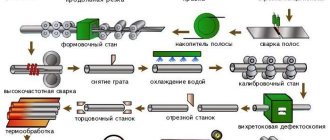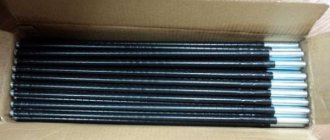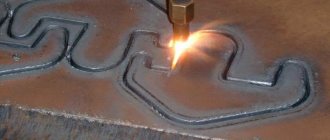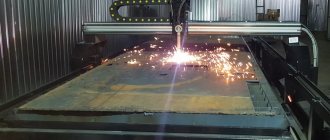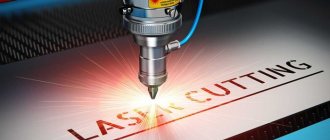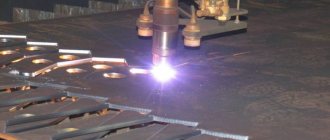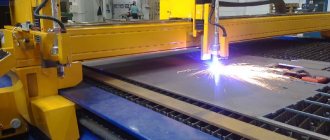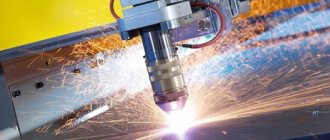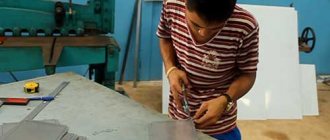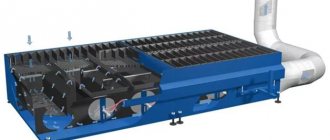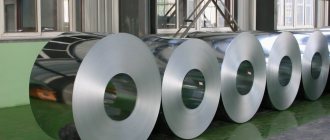Home / Library / News / Thermal metal cutting machines: which type is right for your production?
CNC thermal cutting machines are widely used in many areas of material production. Almost any enterprise specializing in working with metal uses thermal cutting. Often these machines have a portal design with driven carriages on a cross beam that move the working tool. As a working tool, a gas cutter, a plasma torch, a nozzle with a narrow diameter hole for focusing the jet, and a head with lenses for focusing the laser beam can be used.
Each cutting technology has its own advantages, features and limitations. When choosing a cutting technology, you should pay attention not only to the cost of the machine itself, but also to the cost of its maintenance and consumables.
Machine cutting of metal: principle of operation and types
Machine cutting helps speed up monotonous metal cutting processes and improve the quality of the result. They use the same operating principles as manual equipment: a mixture of flammable gas and oxygen to form a flame, as well as supplying a jet of cutting oxygen, or air plasma cutting with a jet of air from a compressor and an electric arc. In the latter type, the air is heated by the arc and turns into a plasma state, which is used for cutting. The difference between automatic installation and manual installation is that the machines have CNC, which fully controls the movements of the burner. The cutting head with nozzle moves on brackets and rollers, ensuring uniform passage and precision. The operator can only place the part on the table and run the program.
Types of metal cutting machines are divided into:
- cutting method (which affects the metal);
- dimensions (for garage or production);
- structural design;
- cut thickness (from 1.5 to 300 mm).
Another difference is the cleanliness of the cut, where after some you can immediately weld the parts, while after others you will need to lightly clean the angle grinder.
Large and powerful thermal cutting machines are used in factories and other metalworking plants. In the private sector, compact machines are used at a relatively affordable price, located on a workbench or a separate stand, which can easily fit in a garage or small workshop. The main advantage of thermal cutting machines is the complete automation of the process.
Gas cutting
Gas (gas-oxygen) cutting has a limited range of processed materials (low-alloy and carbon steels) due to their physical characteristics (the melting temperature of the metal is required so that it can be cut by a jet of compressed oxygen), but at the same time this type of cutting allows you to cut both medium and large thicknesses (recommended range 3 – 300 mm).
The cutting process occurs as follows: first, the metal is preheated to the melting temperature, then a stream of oxygen is supplied to the place of local melting for a separation cut.
After the gas cutting procedure, scale is formed at the end of the resulting part, which requires subsequent mechanical processing.
Operating costs (this includes the cost of gases and consumables) for oxy-fuel cutting are low, and servicing the machine is not very difficult (provided the machine is operated).
Obvious advantages of this method: a wide range of thicknesses, ease of operation, versatility in relation to the environment.
Disadvantages: processing of low-alloy and carbon steels, high thermal influence in the cutting zone, low cutting speed.
What can you do with machine cutting?
Cutting machines are used to automate and speed up the process. The equipment is capable of cutting workpieces along straight or wavy lines for further welding, chamfering edges, or cutting finished metal products (benchmen’s keys, flanges, metal decorations for fences, fragments of stairs, etc.). Depending on the type of torch installed, the machines cut carbon steel, stainless steel and aluminum. Batch cutting of thin 1.0 mm sheets is possible, reducing thermal deformation and the formation of smelted iron in the slag, as if each sheet was cut separately.
What types of machines are used to cut metal largely determine the production tasks. The more powerful the current source, the greater the thickness the torch will cut through. The more functional the device, the more complex shapes it can cut. The accuracy of the finished part depends on the flame source, and the dimensions of the work table determine the maximum size of the workpieces processed.
The speed of gas-flame machine cutting is much higher than that of manual cutting. Preparatory straight cutting on a sheet 5 mm thick is carried out at a speed of 660 mm per minute. On a workpiece with a cross-section of 300 mm, this figure is 110 mm/min. Cutting of shaped elements is possible up to 590 mm at a thickness of 5 mm in 60 seconds.
The use of machine cutting allows you to narrow the working area, concentrating the implementation of numerous preparatory processes in one place. This also helps to save on the number of personnel, where one or two people will be required to install parts, depending on the dimensions of the product. Cutting material using a machine provides high accuracy and protects against human error and defects due to the high error of manual cutting. Automatic machines can cut narrowly and leave less waste, which reduces material costs. With such equipment, production volumes increase.
I guarantee that in the future we will have tons of useful materials and insights from the world of industrial equipment - don’t forget to subscribe to the newsletter so you don’t miss out!
Dmitry Yagolnik
Welding Equipment Expert
Design features of the KING, Dekart series
As standard, the machine is equipped with a 10-inch color controller CNCUT-10A and a new plasma THCZZ-PTHC. Support with dual function of plasma and oxy-fuel cutting. Rails. Oxygen gas cutter. There are several sizes of this machine.
CNC device of KING machine
The CNC system is a two-axis digital controller for machines using plasma torches or oxygen gas torches for cutting. All operations have menus and graphical prompts, a complete package of functions, everything is clear and easy to operate. The system uses ARM9 high-speed control structure and DSP to make the cutting process more stable and reliable.
- Display: 10.4" 800*600 high resolution LCD, 260,000 colors
- CPU: ARM9 industrial chip
- File storage: 1G electronic storage
- Memory: 256M
- External interface: USB
- Keyboard: PS2 interface, PCB based keyboard
- Chassis: Fully shielded metal construction. Protection against electromagnetic radiation and static voltage
- System operating power: DC + 24V
- System operating environment: temperature -10°C to +60°C; relative humidity 0-95% non-condensing
- Language support: English, Russian, Chinese
- Library of standard parts: more than 40 standard blanks with variable sizes and types of parts (hole, part)
- Calibration of the rotation angle of the part relative to the sheet. The system can rotate a part (group of parts) relative to the sheet. It is enough to specify two points on the edge of the sheet and the entire coordinate system will unfold parallel to the sheet. You can also manually enter the rotation angle of the parts.
- Parts layout function. The operator, without the participation of a programming engineer, can reproduce parts on the CNC, indicating the required number of parts and the type of layout (matrix, checkerboard, cell).
- Ability to save completed programs in internal memory and USB storage. Ability to edit programs through a text editor.
Description of G and M codes
| Code | Function | Code | Function |
| G99 | Rotation Scale Mirror (XY) | G00 | Fast travel |
| G92 | Setting coordinates | G01 | Linear interpolation |
| G91 | Relative coordinate system | G02 | Circular interpolation clockwise |
| G90 | Absolute coordinate system | G03 | Circular interpolation counterclockwise |
| G20 | English system (in inches) | G04 | Program stop (pause) |
| G21 | Metric system (in millimeters) | M07 | Turning on cutting (plasma, gas) |
| G41 | Cutting width compensation on the left | M08 | Turn off cutting |
| G42 | Cutting width compensation on the right | M02 | End of the program |
| G40 | Canceling cutting width compensation |
Software
FastCAM has a 30-year R&D history and is a well-known brand in the world of cutting and welding industry. FastCAM software is professional in drawing, embedding and programming for NC gas, plasma, laser and waterjet cutting. It is easy to learn and use without a PC or AutoCAD. FastCAM provides multilingual software, technical support and training in the Americas, Europe, Asia Pacific and China. FastCAM promotes new technologies to increase productivity, improve quality and reduce costs.
FastCAM software has four modules for CNC cutting:
FastCAM drawing module:
- Draw: similar to CAD, for drawing all kinds of parts
- Compatible with CAD and Optimizer: Read and optimize DXF/DWG files by deleting, compressing, extracting, exploding
- Cutting functions: Kerf compensation, plasma bridge, general line trim, corners, CAD layers, word mark
FastNEST automatic nesting module:
- Manual attachment, simple and convenient to use
- Automatic nesting in a row or matrix
- Full automatic nesting
- Interactive nesting via automatic and manual nesting
- Regular cut and continuation cut to reduce pre-breakdown
- Residue nesting for irregular remains or parts
FastPATH automatic filtering module:
- Programming: Automatic and manual control includes marking, path optimizer, multi-layer cutting
- Supports multiple CNC controls, ESSI and EIA G/M code
- SupportKerfs comp, pre-pierce, stitch & tag cutting
FastPLOT check module:
- CNC control: automatic and manual simulation, dimensional compensation and correction testing
- Cost calculation: usage, cut length, cost of piercing and cutting
- Transfer NC files to CAM/DXF/DWG files.
Examples of justified use of thermal cutting machines
The benefits of using thermal cutting machines increase in proportion to the frequency of their use. If the enterprise has the same type of metal cutting processes, where accuracy is important, and there is potential for increasing sales of finished products, then automation will significantly speed up production and increase profitability. For example, in a factory that produces metal doors, it will be advantageous to set the cut dimensions of steel sheets for the blade, with cutting keyholes, mortise hinges, and solid-formed profile parts, which can then be immediately put into use (bent, welded) without first cleaning the edges with a grinder.
In contrast to air plasma cutting machines, hydraulic guillotines, which are cheaper and often used in the manufacture of metal doors, can only perform an even cut in a straight line, and some operations will have to be carried out manually with a plasma cutter. In this case, the accuracy of the result decreases and you will have to refine the parts with a grinding machine, which significantly slows down the production process.
Thermal cutting machines are also useful for producing attachments for agricultural machinery. In the CNC, you can set the dimensions of the parts and the machine will quickly and accurately cut out blanks for excavator buckets, soil cutter covers, various plows and cutters, augers, and the welder will only have to assemble the structure and weld.
Automatic devices are also justified in the case of serial production of metal furniture. The equipment will accurately cut parts for cabinets, workbenches, and jigs. All elements will have the same dimensions and can be welded immediately without preliminary cleaning.
Advantages:
- Stable operation, high frequency effective plasma, lightweight portable design;
- Supports two cutting methods - flame and plasma;
- Economic advantages - structure and design, easy to operate;
- High cutting quality, high contour repeatability accuracy
The most effective use of plasma cutting technology when cutting steel sheets up to 20-25 mm thick, with carbon steel thicknesses over 30 mm, it is advisable to use gas flame technology. This product is designed for large, medium and small enterprises, widely used in the production of automobile, shipbuilding, and other engineering equipment, agricultural machinery. It is used for cutting carbon steel (gas cutting), as well as stainless steel (plasma cutting). Drawings made in CAD programs are the basis for creating a control program. Most modern design programs allow you to save drawings in *DXF format (such as AutoCAD, SolidWorks, Compass). Using the software supplied with the equipment, computer graphics in *DXF format can be reduced to G code. The equipment is equipped with a USB interface for convenient transfer of the control program.
How to determine the profitability of automation?
The profitability of using machines for thermal cutting of metal is determined by two factors: the volume of cutting and the requirements for accuracy. When in production processes it is necessary to cut a small volume of workpieces, for example, parts for the production of 10-20 barbecues per month, and most of the time is spent on assembly and packaging, then the use of automatic cutting is not justified. But the situation is changing when the production of barbecues is carried out on a global scale at 300-1000 units per month and there is a large distribution network for the products. In such cases, everyday similar processes of cutting, chamfering and other operations performed automatically will significantly speed up the production of goods and reduce the number of people involved.
The second factor is the requirements for cutting accuracy. If expensive metals are used in production (sheets or pipes made of stainless steel, aluminum, etc.), then high-precision cutting with a narrow cut and a minimum of waste will help reduce material costs. The use of machines for automatic cutting of metals is also justified in cases where high precision is required for parts that will then be used in structures that do not allow dimensional errors (flanges of pipes and containers with high pressure, manifolds of chemical plants, complex water filters, etc.) . Manual cutting will not provide such precision and will take longer, so it is beneficial to buy an automatic machine and optimize the production process.
Equipment of the KING series machine, Dekart
| № | Name | Qty | Unit change | Specification |
| 1 | KING 2040G/2540G | 1 | PC. | With aluminum guides |
| 2 | Portal frame | 1 | PC. | Aluminum profile and 45 steel beam |
| 3 | Distance between rails along the Y axis | from 2000 to 2500 mm | mm | Effective cutting width from 1500 mm to 2000 mm |
| 4 | Y axis length | 4000 mm | mm | Effective cutting length 3,000 mm |
| 5 | X-axis drive system | 1 | PC. | 57 or 86 series stepper motor with gearbox |
| 6 | Y axis drive system | 2 | PC. | 57 or 86 series stepper motor with gearbox |
| 7 | Z axis drive system | 1 | PC. | Stepper lifting motor |
| 8 | Gearbox | 3 | PC. | German brand made in China |
| 9 | CNC controller | 1 | PC. | CNCUT-10A 10.4 inch controller |
| 10 | Cable protection when moving along the X and Y axis | 2 | PC. | Chain type industrial cable duct |
| 11 | X axis linear guide | 2 | PC. | |
| 12 | Y-guide | 2 | PC. | T90 Heavy Duty Rail |
| 13 | Control cabinet | 1 | PC. | With OMRON, SIEMENS, SCHNEIDER components |
| 14 | Cutting mode | 1 | PC. | Plasma and oxy-fuel cutting |
| 15 | Oxygen gas burner | 1 | PC. | Longteng |
| 16 | Controller software | 1 | PC. | FLSK 2300 |
| 17 | Attachment software | 1 | PC. | FASTCAM STANDARD VERSION |
| 18 | THC Arc Height Control Device | 1 | PC. | PTHC |
| Stepper motors | Gearbox | Gear |
| Rails | Rack | FastCam Software |
Types of machines by cutting method
For cutting, machines use three main processes: air-plasma, gas-flame (air-fuel) and laser. But the third one is too expensive and specific, so we will consider only the first two. Each has its own characteristics and advantages.
Air plasma cutting
Here a current source works, forming an electric arc. The compressor pumps air passing through the nozzle. When the arc is heated, the air flow turns into a plasma state that can cut solid materials. The more powerful the device, the greater the thickness the machine will cut. The current range of such machines is from 40 to 300 A, which allows cutting steel sections from 6 to 60 mm. This cut is very narrow and has a smooth edge that does not require further machining.
Technical oxygen (O2) can be supplied together with compressed air (Air). This ensures smooth, high-speed cutting of ferrous metals. After cutting, the surface is immediately ready for welding. Using only ordinary air (Air) as a plasma-forming and shielding gas produces a thinner slot and saves material. This combination is suitable for mild steel and non-ferrous metals.
Here are some of the most popular machines that support this cutting method:
- SIBERIA ARM K 1.5/3.0 - model with CNC and three-coordinate movement of the cutting head. Supports automatic metal search and torch height above it. Plasma is generated from an inverter-type current source Sibir 105 PR. The dimensions of the working area are 1500x3000 mm, and the maximum cut thickness reaches 100 mm.
- Svarog Valiant 3.0 is a new product from the welding brand, which has a high control accuracy of 0.1 mm. Supports air plasma and gas plasma cutting. Equipped with a manual tilt of the plasma torch for chamfering, there is protection against electromagnetic interference. CNC with 4 GB memory for storing part templates. Control programs interact with the computer-aided design system, which results in minimal material waste.
Flame cutting (air-fuel cutting)
In equipment with this process, three channels fit into the burner:
- flammable gas (methane, acetylene or propane);
- technical oxygen to support combustion;
- cutting oxygen for cutting already heated metal.
This is a rougher method of machine cutting, allowing you to cut metals with a thickness of 200-300 mm, but with less evenness of the edge. It will not be possible to immediately weld the workpieces and you will have to process the edges with a grinder. But the cutting process is very fast.
An excellent option for a machine with this cutting method is the Messer Quicky-E. It refers to portable machines that run on flammable gas and oxygen. Supports forward and reverse movement at operator-settable speeds, as well as circular cutting of flanges. It is designed for field use and is convenient for frequent transportation. Maximum cutting thickness 100 mm.
Some machines are universal and support work with both types of burners (air-plasma and air-fuel), which expands the possibilities for their operation.
Plasma cutting
Plasma is the so-called “fourth” state of matter, which is formed using a high-temperature electric arc (which is ignited between the electrode and the nozzle/product) and air or a special gas under high pressure.
The plasma obtained during this process has high electrical conductivity, with the help of which it heats the metal until it melts, then compressed gas is supplied to the cutting zone to blow this metal out of the cut zone.
The following gases are used in plasma cutting:
- Active - oxygen, air.
- Inert - nitrogen, argon, hydrogen.
Advantages of this method:
- A wide range of options for plasma cutting allows you to cut any metals from ferrous, non-ferrous to special alloys;
- The ability to control the plasma arc for cutting round holes, plasma marking;
- The cutting speed of small and medium thicknesses is much higher than gas cutting;
- A small heat-affected zone, providing small thermal shocks and slight burnout of alloying elements;
- A good end after cutting, which does not require subsequent machining.
The disadvantages of plasma cutting are:
- Arc taper (with insufficient control, the edge cut will be uneven);
- High noise level;
- When cutting, a lot of harmful fumes are generated, which must be collected and filtered in time;
- The cost is higher than gas cutting.
Types of machines by design
Leading manufacturers of welding equipment ESAB, Fubag, Svarog and others have developed various types of machines for cutting metal: compact ones installed in a garage that cut workpieces in an area of up to 1 m2, or large machines for cutting giant parts up to 30 m in length. Based on their design, such installations are divided into two categories.
Portal type
The portal-type thermal cutting machine has a U-shaped frame that moves on rails. A cutting head is fixed to the bracket, capable of making transverse movements and moving away or approaching the surface in height. Due to this design, the length of the workpieces can be from 1 to 30 m. But the machine requires enough space in the workshop and is intended for stationary use. A CNC portal-type thermal cutting machine is suitable for cutting straight and wavy lines, chamfering and cutting out large and small parts according to a template embedded in the program block or entered values.
Here are some popular portal type machines:
- SIBERIA ARM 1.0/1.0 is one of the smallest machines with a working field of 1000x1000 mm. The installation cuts metal with a thickness of up to 12 mm with plasma. The cutting accuracy is 0.5 mm. You can connect to the machine via Wi-Fi or an Ethernet network connector remotely to monitor the process or track errors.
- ESAB SUPRAREX SXE BIG is one of the largest portal-type models with two transverse carriages. Capable of simultaneously cutting two independent lines in one step, increasing productivity. Supports cutting with plasma and oxy-fuel flames. The bevel angle can be adjusted even during the cutting process. Can cut lattice sheets.
Console type
The second design option is a cantilever-type thermal cutting machine. The machine is equipped with runners or rails located close to each other, which are installed on the side of the workpiece or directly on it (for large sizes and a flat surface). The cutting head is mounted on a bracket and makes longitudinal and transverse movements for cutting of varying complexity. The machine can be used with or without a table. The device supports operation in a partially mobile mode - it can be transported in a minibus or pickup truck to the work site and cut workpieces there, and then returned to the garage or workshop.
Here are some popular units from this category:
- MESSER PORTACUT is a console machine with a small block that allows you to adjust the speed of movement of the cutting head and the position of the flame in terms of inclination and height. Able to cut circles, make curved lines, straight cuts and at an angle. It is one of the most affordable devices in terms of price.
- Fubag INCUT 10 is a CNC console type thermal cutting machine. It has a display, control panel and software for setting a cutting map with minimal metal waste. During operation, you can also load external cutting control programs via the USB connector.
Key Features and Benefits
- Stable operation, high frequency effective plasma, lightweight portable design.
- Supports two cutting methods - gas flame and plasma.
- Economic advantages – design and design, easy to operate.
- High cutting quality, high repeatability of the contour of the cut parts.
- The most effective use of plasma cutting technology when cutting steel sheets up to 20-25 mm thick; for carbon steel thicknesses over 30 mm, it is advisable to use gas-flame technology.
- Built-in THC (Torch Height Control) system – torch height adjustment system.
- Drawings made in CAD programs are the basis for creating a control program.
- The software allows you to save drawings in .dxf format, compatible with most design programs (such as AutoCAD, SolidWorks, Compass).
- Using the machine's software, computer graphics in .dxf format can be reduced to G-code.
- The machine is equipped with a USB interface for convenient transfer of the control program.
Design features of a gas machine
Equipment for cutting metal of this type is equipped with a special head, from which a stream of oxygen mixed with flammable gases escapes under pressure. The tables in this type of gantry machines have a special design that allows them to withstand high temperatures and the load of very heavy workpieces. Like plasma machines, such machines have a cutter, devices for moving it and a control system. During operation, gas is supplied from connected cylinders. Cutting safety is ensured by special fireproof valves.
Types of machines
Currently, the following main types of thermal cutting are used in production:
- plasma;
- oxygen (gas);
- laser
Machines designed to perform each of these operations may differ in design, functionality and dimensions.
